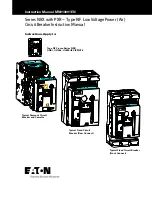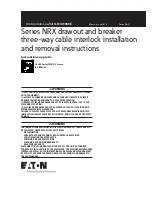
20
The closing coil cannot be electrically energized
unless the closing spring is completely charged.
This action is prevented by the 52/CHG switch
in the closing circuit. (Figure 13, Item 6)
5-3 Trip Free Operation
The linkage is mechanically trip-free in any lo-
cation on the closing stroke. Electrically ener-
gizing the trip coil while closing will, after the
auxiliary switch contacts change position, ro-
tate the trip latch and permit the circuit breaker
to open fully. The linkage will reset as in a nor-
mal open operation and the closing spring will
recharge as described under “CLOSE SPRING
CHARGING”.
5-4 Closing Operation
By either energizing the close solenoid or de-
pressing the manual close button(Figure 1 , Item
8) the close latch (Figure 15, Item 5) is rotated,
releasing the closing spring (Figure 13, Item 1).
This action releases the energy in the closing
spring and transmits it to the closing cam (Fig-
ure 16, Item 1) and closing roller (Figure 16, Item
2) causing the linkage to rise until the close prop
(Figure 16, Item 3) can slip under the close roller
(Figure 16, Item 2) and hold the linkage in place.
As the linkage moves, the primary drive crank
(Figure 16, Item 5) rotates the primary cross shaft
(Figures 16 & 17, Item 4) which in turn rotates
the outer phase bell cranks. (Figure 17, item 2)
Figure 15. Electrical Charging system
right side view
1 Charging arms
5 Close latch
2 Ratchet wheel
6 Charging motor
3 Driving pawl
7 52 LCS switch
4 Holding pawl
8 Trip latch
Spring charging is accomplished electrically by
a rotating eccentric on the output shaft of a
gear motor (Figure 15, Item 6) which in turn
drives pivoted charging arms (Figure 15, Item
1). The charging arms oscillate about the
centerline of a ratchet wheel (Figure 15, Item 2).
A driving pawl (Figure 15, item 3), mounted
within the charging arms, oscillates with the
charging arms. Starting from its rear-most posi-
tion, the charging arms rotate forward, while
spring forces engage the driving pawl with a
tooth on the ratchet wheel. The ratchet wheel is
advanced by the rotating charging arms and pawl
assembly. Advancement of one tooth spacing
is provided for each oscillation of the system.
The ratchet motion is restricted to one direc-
tion by a spring-loaded holding pawl (Figure
15, Item 4) that prevents the ratchet wheel from
going backwards as the charging arm oscil-
lates back to pick up the next tooth. Thirteen
complete cycles of the charging arms are needed
for a full charge of the closing spring. The effi-
cient, compact gear motor accomplishes this
action in about two seconds. When the charg-
ing cycle is complete, the ratchet wheel is posi-
tioned so that a missing tooth is adjacent to the
driving pawl and any motor overspin will not
drive the ratchet wheel, thus preventing dam-
age to the system.
PowerVac
®
5kV Vertical Lift
Chapter 5. Operation
1
Closing cam
4 Primary cross shaft
2
Closing roller
5 Primary drive crank
3
Close prop latch
6 Trip latch
Figure 16. Closing linkage left side view
View rotated
90 degrees









































